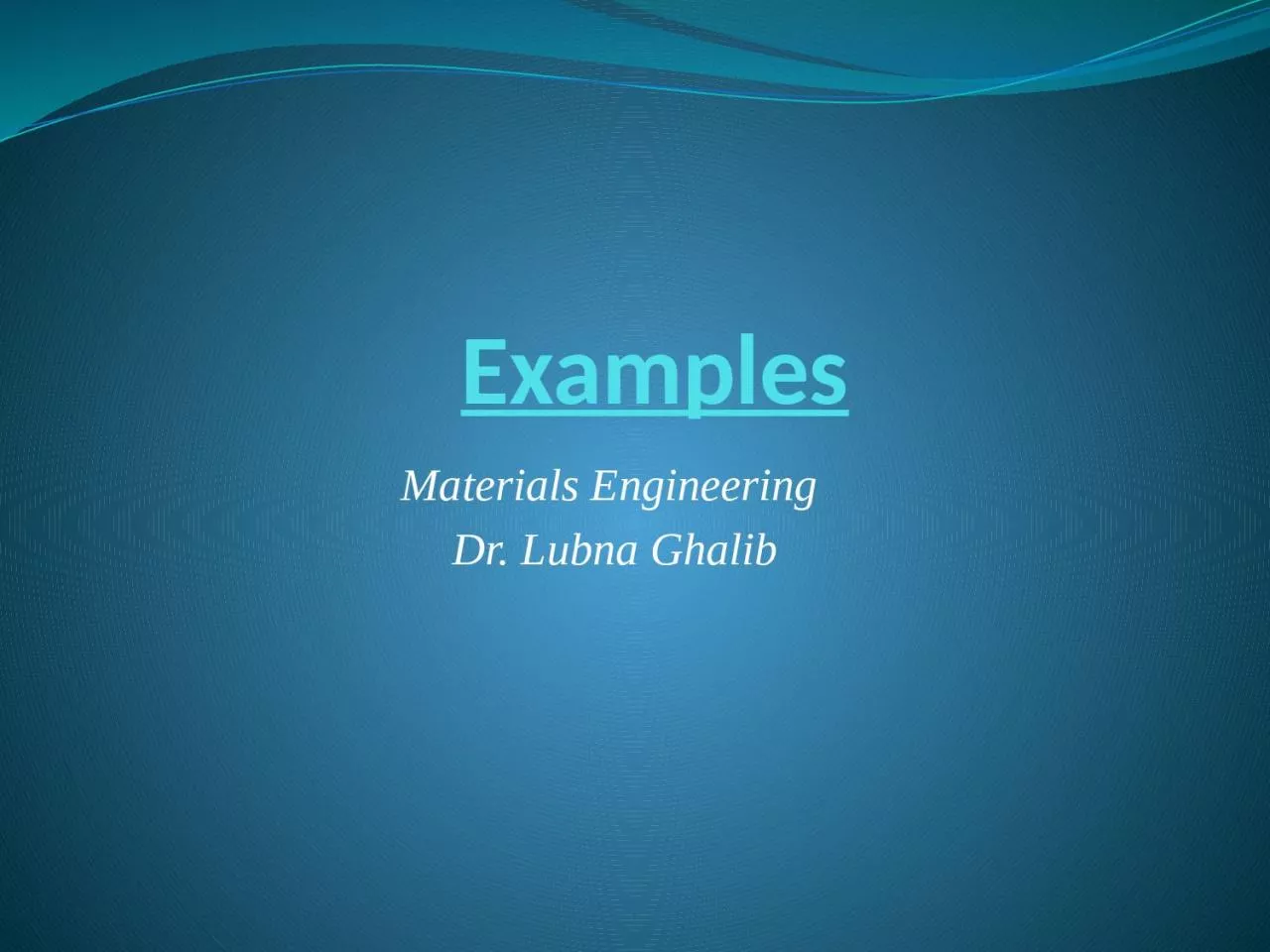

Dr Lubna Ghalib Example 5 A galvanic cell consist of Zn electrode in ZnSO 4 solution with 1 mole concentration The other is of Ni electrode in NiSO 4 solution with 1 mole concentration The two electrodes are separated with porous partition to prevent mixing o ID: 1002468
Download Presentation The PPT/PDF document "Examples Materials Engineering" is the property of its rightful owner. Permission is granted to download and print the materials on this web site for personal, non-commercial use only, and to display it on your personal computer provided you do not modify the materials and that you retain all copyright notices contained in the materials. By downloading content from our website, you accept the terms of this agreement.
1. ExamplesMaterials Engineering Dr. Lubna Ghalib
2. Example 5: .A galvanic cell consist of ( Zn ) electrode in( ZnSO4 ) solution with ( 1 mole ) concentration. The other is of (Ni) electrode in (NiSO4) solution with (1 mole) concentration. The two electrodes are separated with porous partition to prevent mixing of the two solutions. The two electrodes are contacted with conductive wire. Finda) On which electrode the oxidation reaction will be.b) Which electrode will be the anode.c) Which electrode will corrode.d) What is the emf for this galvanic cell, circuit close.
3. Example 5: .Solution:The half cells reactions are: Zn2+ + 2e- Zn Eo= - 0.763 VNi2+ + 2e- Ni Eo= - 0.250 V (a) Oxidation reaction will take place on Zn electrode .Because the potential difference in Zn half-cell more negative (- 0.763 V) compare with (-0.250 V) for Ni half Cell.(b) From previous answer, Zn electrode is the anode, because the oxidation reaction takes place on anode electrode.(c) In galvanic cell, the anode electrode is the corroded electrode, for that Zn electrode will corroded.
4. Example 5: .Solution:(d) Cell potential is the sum of the two half cells potential. Anodic reaction: Zn Zn2+ + 2e- Eo= + 0.763 VCathodic reaction: Ni2+ + 2e- Ni Eo= - 0.250 VFinal reaction Zn + Ni2+ Zn2++ Ni Eocell= + 0.513 V
5. Example 6: .if we connect Pt electrode with Cu electrode we get: Pt 2+ + 2e- Pt Eo = + 1.200 VCu2+ + 2e- Cu Eo= + 0.337 VBy subtraction the lower potential from the higher we get Oxidation: Cu Cu2+ + 2e- Eo= - 0.337 VReduction Pt 2+ + 2e- Pt Eo = + 1.200 V Eocell= + 0.8633 V
6. Example 7: .If the galvanic Cell contain two electrodes, One of them with ( - ve ) potential and the other with ( + ve ), such as Zinc with Copper.Zn2+ + 2e- Zn Eo= - 0.763 VCu2+ + 2e- Cu Eo= + 0.337 V Oxidation Zn Zn2+ + 2e- Eo= + 0.763 VReduction Cu2+ + 2e- Cu Eo= + 0.337 V Eocell= + 1.100 V
7. Example 8: .Write the reactions of the anodic half cell (oxidation) and cathodic half cell (reduction). For the following electrodes and electrolytes, by using standards potential values:(a) Zinc and copper electrodes are immersed in dilute (CuSO4).(b) Copper electrode is immersed in water saturated with oxygen.(c) Iron electrode is immersed in water saturated with oxygen.(d) Magnesium electrode is immersed in water saturated with oxygen.
8. Example 8: .a) Oxidation ( Anodic reaction ) Zn Zn2+ + 2e- Eo= + 0.763 VReduction ( Cathodic reaction ) Cu2+ + 2e- Cu Eo= + 0.337 VWe observed that Zinc reaction possess more negative, so it is the anode and oxidation reaction occurred on it.b) May be there is a low rate corrosion or maybe there is no corrosion , because the potential difference between Cu oxidation (0.337 V) and that formed in water from hydroxide ion (0.401 V) is very small.
9. Example 8: .Cu2+ + 2e- Cu Eo= + 0.337 VO2 + 2H2O + 4e- 4OH- Eo= + 0.401 VOxidation Cu Cu2+ + 2e- Eo= - 0.337 VReduction O2 + 2H2O + 4e- 4OH- Eo= + 0.401 Vc) Iron potential's difference is more negative, so it is the anode and oxidation reaction occurred on it.Oxidation ( Anodic reaction )Fe Fe 2+ + 2e- Eo= + 0.440 VReduction (Cathodic reaction) O2 + 2H2O + 2e- 4OH- Eo= + 0.401 V
10. Example 8: .d) Mg is more negative in potential, so it is the anode and oxidation reaction occurred on it.Oxidation ( Anodic reaction )Mg Mg2+ + 2e- Eo = + 2.370 V Reduction (Cathodic reaction) O2 + 2H2O + 2e- 4OH- Eo= + 0.401 V